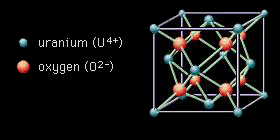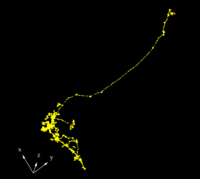Difference between revisions of "TF PR UO2damage"
| Line 4: | Line 4: | ||
Uranium Oxide is a common fuel used for generating power in nuclear reactors. | Uranium Oxide is a common fuel used for generating power in nuclear reactors. | ||
| − | [[File:UO2.png | | + | [[File:UO2.png | 400px]] |
<center>[[File:UO2.png|"thumb"|"border"|"center"|"middle"|"upright"|||page=Page||Figure 2: An Uranium Oxide lattice structure. ]]</center> | <center>[[File:UO2.png|"thumb"|"border"|"center"|"middle"|"upright"|||page=Page||Figure 2: An Uranium Oxide lattice structure. ]]</center> | ||
| Line 10: | Line 10: | ||
As the Xenon atom travels through the Uranium Oxide, Uranium and Oxygen atoms are removed from their stationary positions. These atoms can either end up in new positions within the material that were not originally positions held by atoms or replace previously knocked out atoms. These two conditions, referred to as interstitial and replacements are the two possibilities for the atoms after irradiation damage. The original atom positions can also remain empty, creating what are termed vacancies within the lattice. All three conditions are the main descriptions of how materials are damaged by atoms after such an event. My work has focused on building a new model using GEANT4 to update and improve on previous methods used to perform a Binary Collision Approximation. | As the Xenon atom travels through the Uranium Oxide, Uranium and Oxygen atoms are removed from their stationary positions. These atoms can either end up in new positions within the material that were not originally positions held by atoms or replace previously knocked out atoms. These two conditions, referred to as interstitial and replacements are the two possibilities for the atoms after irradiation damage. The original atom positions can also remain empty, creating what are termed vacancies within the lattice. All three conditions are the main descriptions of how materials are damaged by atoms after such an event. My work has focused on building a new model using GEANT4 to update and improve on previous methods used to perform a Binary Collision Approximation. | ||
| − | + | [[File:Damage.png| 200 px ]] | |
| − | |||
[[User_talk:Foretony#Public_Relations]] | [[User_talk:Foretony#Public_Relations]] | ||
Revision as of 19:25, 28 February 2019
User_talk:Foretony#Public_Relations
Uranium Dioxide
Uranium Oxide is a common fuel used for generating power in nuclear reactors.

As the Xenon atom travels through the Uranium Oxide, Uranium and Oxygen atoms are removed from their stationary positions. These atoms can either end up in new positions within the material that were not originally positions held by atoms or replace previously knocked out atoms. These two conditions, referred to as interstitial and replacements are the two possibilities for the atoms after irradiation damage. The original atom positions can also remain empty, creating what are termed vacancies within the lattice. All three conditions are the main descriptions of how materials are damaged by atoms after such an event. My work has focused on building a new model using GEANT4 to update and improve on previous methods used to perform a Binary Collision Approximation.
